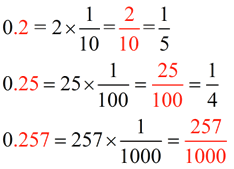On this web page, we will be dealing with "nice" decimals and fractions.
These decimals and fractions will be values that can be easily converted to other forms.
The more difficult conversions will be discussed under Real Numbers & Rationals.
Decimal to Fraction:
• Remember that the decimal "locations" represent tenths, hundredths, thousandths, and so on.

• notice that the number of zeros following 1 in the denominators is the same as the number of digits following the decimal point in the original value.
|
|
Fraction to Decimal:
• To convert a fraction to a decimal, divide the numerator by the denominator.

|
When writing a decimal, it is customary to place a 0 in the "ones" position if the decimal is less than one.
While .25 is acceptable,
0.25 is more precise.
The leading "0" points out that a decimal is being used in the number, and it puts emphasis on the fact that this value is less than one. |
|
Examples:
1. Express  as a decimal. Answer: 0.06
2. Express two hundred thirty-seven and five tenths as a decimal value. Answer: 237.5
3. Express  as a decimal. Answer: 0.4 as a decimal. Answer: 0.4
(divide 2 by 5, or express as 4/10 and convert to decimal)
4. Twenty out of one hundred backpacks are blue. Express the number of the backpacks that are blue as a decimal. Answer: 20/100 = 0.20 or 0.2
5. a) Place these decimal values in order from smallest to largest:
0.35, 0.24, 0.05, 0.21, 0.13, 0.55
Answer: 0.05, 0.13, 0.21, 0.24, 0.35, 0.55
b) As a check, convert the ordered list to fractional values.
Answer: 

|
For help with conversions between fractions and decimals
on your calculator,
click here. |
|
|